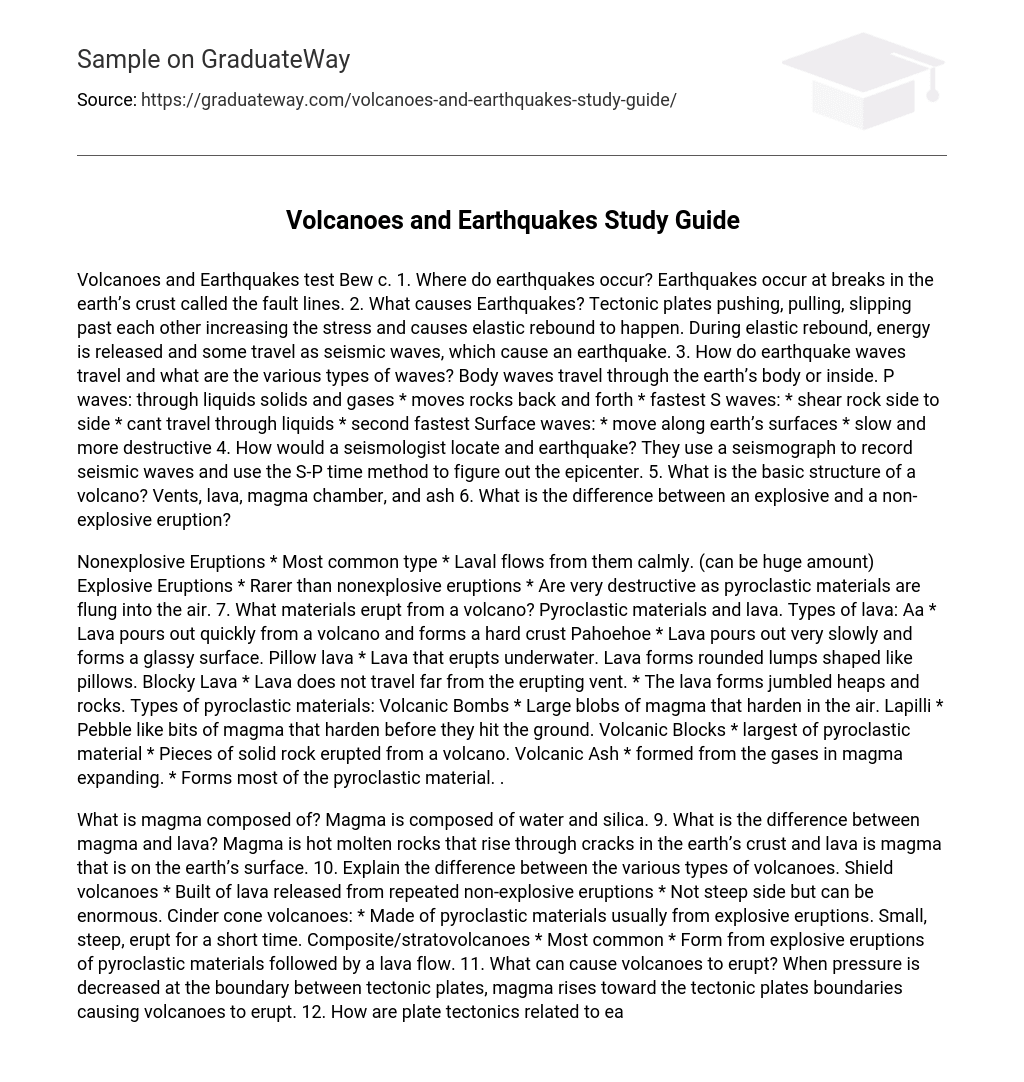Volcanoes and Earthquakes test Bew c. 1. Where do earthquakes occur? Earthquakes occur at breaks in the earth’s crust called the fault lines. 2. What causes Earthquakes? Tectonic plates pushing, pulling, slipping past each other increasing the stress and causes elastic rebound to happen. During elastic rebound, energy is released and some travel as seismic waves, which cause an earthquake. 3. How do earthquake waves travel and what are the various types of waves? Body waves travel through the earth’s body or inside. P waves: through liquids solids and gases * moves rocks back and forth * fastest S waves: * shear rock side to side * cant travel through liquids * second fastest Surface waves: * move along earth’s surfaces * slow and more destructive 4. How would a seismologist locate and earthquake? They use a seismograph to record seismic waves and use the S-P time method to figure out the epicenter. 5. What is the basic structure of a volcano? Vents, lava, magma chamber, and ash 6. What is the difference between an explosive and a non-explosive eruption?
Nonexplosive Eruptions * Most common type * Laval flows from them calmly. (can be huge amount) Explosive Eruptions * Rarer than nonexplosive eruptions * Are very destructive as pyroclastic materials are flung into the air. 7. What materials erupt from a volcano? Pyroclastic materials and lava. Types of lava: Aa * Lava pours out quickly from a volcano and forms a hard crust Pahoehoe * Lava pours out very slowly and forms a glassy surface. Pillow lava * Lava that erupts underwater. Lava forms rounded lumps shaped like pillows. Blocky Lava * Lava does not travel far from the erupting vent. * The lava forms jumbled heaps and rocks. Types of pyroclastic materials: Volcanic Bombs * Large blobs of magma that harden in the air. Lapilli * Pebble like bits of magma that harden before they hit the ground. Volcanic Blocks * largest of pyroclastic material * Pieces of solid rock erupted from a volcano. Volcanic Ash * formed from the gases in magma expanding. * Forms most of the pyroclastic material. .
What is magma composed of? Magma is composed of water and silica. 9. What is the difference between magma and lava? Magma is hot molten rocks that rise through cracks in the earth’s crust and lava is magma that is on the earth’s surface. 10. Explain the difference between the various types of volcanoes. Shield volcanoes * Built of lava released from repeated non-explosive eruptions * Not steep side but can be enormous. Cinder cone volcanoes: * Made of pyroclastic materials usually from explosive eruptions. Small, steep, erupt for a short time. Composite/stratovolcanoes * Most common * Form from explosive eruptions of pyroclastic materials followed by a lava flow. 11. What can cause volcanoes to erupt? When pressure is decreased at the boundary between tectonic plates, magma rises toward the tectonic plates boundaries causing volcanoes to erupt. 12. How are plate tectonics related to earthquakes and volcanoes? When tectonic plates collide, separate, or slip past each other, earthquake and volcanoes occur.





